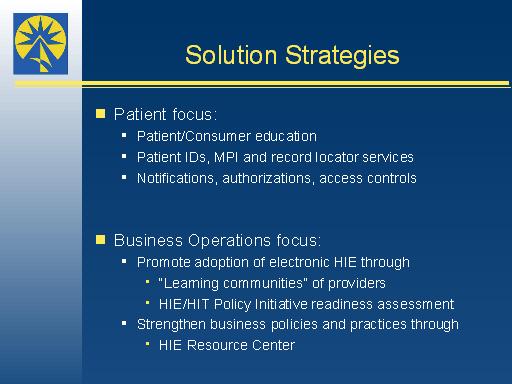Solution Strategies

- Patient focus:
- Patient/Consumer education
- Patient IDs, MPI and record locator services
- Notifications, authorizations, access controls
- Business Operations focus:
- Promote adoption of electronic HIE through
- "Learning communities" of providers
- HIE/HIT Policy Initiative readiness assessment
- Strengthen business policies and practices through
Notes:
Patient focused solution strategies
Patient/Consumer and provider education—information about one's rights; preparation for granting of informed consent; acquisition of technical skills to navigate and interpret stored information.
"Learning communities"—public listening exercises for grass roots solution sharing
Pilot projects: Healthe Mid-America / InformationLinks, Kansas Medicaid Community Health Records
Patient IDs, master patient indexes and record locator services.
Workshops and other public dialogs, followed by development of an "innovation adoption strategy" for assignment of identifiers until best practices emerge or regulations are enacted.
Pilot projects: Kansas Immunization Registry / local health departments and other providers,
Kansas Health Policy Authority / Kansas State Employee Health Plan / Kansas Insurance Department record consolidation, Advanced ID Card Technology Initiative
Patient notifications, authorizations and access controls, including:
access to one's own information and the ability to edit some portion thereof;
control over permitted conditions for data disclosure: how much information, to whom, for what purpose, for how long—i.e., patients' control over the rules;
patient notification, accounting and audit of prospective and retrospective data uses and disclosures;
patient consent, denial or revocation of consent for specific instances of information use and disclosure—i.e., patients' responses to specific authorization requests-as well as those of medical power of attorney and other personal representatives.
Continue participation in NCVHS
Share lessons learned among pilot projects described in 1.b. and 2.b. above to develop a consistent set of policies for patient notifications, authorizations and access controls.
Business operations focused solution strategies
Electronicization—promote adoption of electronic technology for the management of health information through:
"Learning communities"— AAFP
Standards development and interoperability
HIT/HIE Policy Initiative readiness assessment and roadmap to promote development of RHIOs: governance, finance, clinical issues, technology
Pilot projects: Kansas City Regional Electronic Exchange (KCREE), KC CareLink, Browsersoft
Strengthening business policies and practices through a Resource Center that could help coordinate day-to-day business expectations and activities
"Learning communities"—use state's role as convener to build consensus around best practices
State certification of health information exchange organizations
Systems analysis to promote compliance and quality improvement—e.g., 1999 IOM report, "To Err is Human"
 Previous Slide Contents Next Slide
Previous Slide Contents Next Slide 

